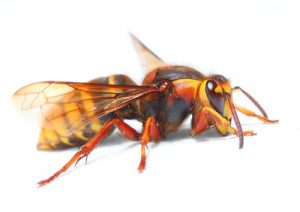European Hornets Can Damage Shrubs
By Chris Williams on May 18, 2011.
Q. Some kind of big wasp is attacking my lilac bush. It looks like it’s chewing on the bark. It looks kind of like a yellowjacket only bigger and darker. Do you know what it is?
A. From your description, you might be dealing with the European hornet. It’s the largest true wasp in the U.S. at 3/4 to more than one inch long. It has yellow and brown stripes on the abdomen like a yellowjacket but has a reddish-brown thorax. European hornets are not nearly as common as other wasps in our area.
 European hornets have a different lifestyle than other wasps in that they can cause damage to various flowering plants (lilacs are its favorite) and fruits. It strips the bark off to feed on the sap. It also uses chewed bark fibers to construct its papery nest. The wasps can actually girdle smaller twigs and the portion of the twig above the girdled area usually dies. The damage may go unnoticed in the spring when only a few workers are active in the nest. By late summer, the damage to the plant caused by the increasing numbers of wasps becomes much more evident. Sometimes the plant dies as a result.
European hornets have a different lifestyle than other wasps in that they can cause damage to various flowering plants (lilacs are its favorite) and fruits. It strips the bark off to feed on the sap. It also uses chewed bark fibers to construct its papery nest. The wasps can actually girdle smaller twigs and the portion of the twig above the girdled area usually dies. The damage may go unnoticed in the spring when only a few workers are active in the nest. By late summer, the damage to the plant caused by the increasing numbers of wasps becomes much more evident. Sometimes the plant dies as a result.
European hornet nests are usually not seen out in the open. Nests are built most often in hollow trees, but also in sheds, barns, bird houses, attics, and wall voids. Nests in unprotected places have a brown, papery covering (the similar nest of the baldfaced hornet has a gray covering). Nests in building voids are made up of 6 to 9 combs with a paper covering, and can have an unpleasant odor. A typical colony is relatively small with 200 to 400 workers. As the nest grows, large insects such as grasshoppers, flies, bees, and yellowjackets are captured by the workers, chewed up, and then fed to the larvae in the nest. Reproductives (next year’s kings and queens) are produced from mid summer into fall. Other hornets in the nest die out in the winter and the same nest is not reused the following year.
Another unusual thing about European hornets is that, unlike other wasps, they are attracted to lights at night. Many a homeowner has been startled when a number of large wasps repeatedly bang loudly against windows beneath outside lights.
European hornets have a large stinger and a painful sting, but they are not very aggressive. They will defend their nest if they are threatened but they attack individually, not together like yellowjackets. Nevertheless, they can be a problem when a person stumbles onto a hidden nest or if the nest is located in a building void, or too close to an entrance or other area where people are active. In that case, give Colonial a call; we can help.